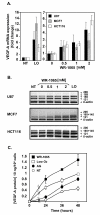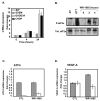The cytoprotective drug amifostine modifies both expression and activity of the pro-angiogenic factor VEGF-A
- PMID: 20334641
- PMCID: PMC2859403
- DOI: 10.1186/1741-7015-8-19
The cytoprotective drug amifostine modifies both expression and activity of the pro-angiogenic factor VEGF-A
Abstract
Background: Amifostine (WR-2721, delivered as Ethyol) is a phosphorylated aminothiol compound clinically used in addition to cis-platinum to reduce the toxic side effects of therapeutic treatment on normal cells without reducing their efficacy on tumour cells. Its mechanism of action is attributed to the free radical scavenging properties of its active dephosphorylated metabolite WR-1065. However, amifostine has also been described as a potent hypoxia-mimetic compound and as a strong p53 inducer; both effects are known to potently modulate vascular endothelial growth factor (VEGF-A) expression. The angiogenic properties of this drug have not been clearly defined.
Methods: Cancer cell lines and endothelial cells were used in culture and treated with Amifostine in order to study (i) the expression of angiogenesis related genes and proteins and (ii) the effects of the drug on VEGF-A induced in vitro angiogenesis.
Results: We demonstrated that the treatment of several human cancer cell lines with therapeutical doses of WR-1065 led to a strong induction of different VEGF-A mRNA isoforms independently of HIF-1alpha. VEGF-A induction by WR-1065 depends on the activation of the eIF2alpha/ATF4 pathway. This up-regulation of VEGF-A mRNA was accompanied by an increased secretion of VEGF-A proteins fully active in stimulating vascular endothelial cells (EC). Nevertheless, direct treatment of EC with amifostine impaired their ability to respond to exogenous VEGF-A, an effect that correlated to the down-regulation of VEGFR-2 expression, to the reduction in cell surface binding of VEGF-A and to the decreased phosphorylation of the downstream p42/44 kinases.
Conclusions: Taken together, our results indicate that amifostine treatment modulates tumour angiogenesis by two apparently opposite mechanisms - the increased VEGF-A expression by tumour cells and the inhibition of EC capacity to respond to VEGF-A stimulation.
Figures






Similar articles
-
In vitro antioxidant properties of amifostine (WR-2721, Ethyol).Cancer Chemother Pharmacol. 2000;45(2):172-6. doi: 10.1007/s002800050026. Cancer Chemother Pharmacol. 2000. PMID: 10663633
-
Amifostine inhibits angiogenesis in vivo.J Pharmacol Exp Ther. 2003 Feb;304(2):729-37. doi: 10.1124/jpet.102.042838. J Pharmacol Exp Ther. 2003. PMID: 12538828
-
Topotecan inhibits vascular endothelial growth factor production and angiogenic activity induced by hypoxia in human neuroblastoma by targeting hypoxia-inducible factor-1alpha and -2alpha.Mol Cancer Ther. 2008 Jul;7(7):1974-84. doi: 10.1158/1535-7163.MCT-07-2059. Mol Cancer Ther. 2008. PMID: 18645007
-
Intracranial meningiomas, the VEGF-A pathway, and peritumoral brain oedema.Dan Med J. 2013 Apr;60(4):B4626. Dan Med J. 2013. PMID: 23651727 Review.
-
Amifostine for protection from antineoplastic drug toxicity.Am J Health Syst Pharm. 1997 Apr 1;54(7):787-800. doi: 10.1093/ajhp/54.7.787. Am J Health Syst Pharm. 1997. PMID: 9099346 Review.
Cited by
-
Amifostine protects vascularity and improves union in a model of irradiated mandibular fracture healing.Plast Reconstr Surg. 2013 Dec;132(6):1542-1549. doi: 10.1097/PRS.0b013e3182a80766. Plast Reconstr Surg. 2013. PMID: 24281582 Free PMC article.
-
Three-Dimensional Cell Metabolomics Deciphers the Anti-Angiogenic Properties of the Radioprotectant Amifostine.Cancers (Basel). 2021 Jun 9;13(12):2877. doi: 10.3390/cancers13122877. Cancers (Basel). 2021. PMID: 34207535 Free PMC article.
-
Evaluation of protective effect of amifostine on dacarbazine induced genotoxicity.Res Pharm Sci. 2015 Jan-Feb;10(1):68-74. Res Pharm Sci. 2015. PMID: 26430459 Free PMC article.
-
Does amifostine reduce metabolic rate? Effect of the drug on gas exchange and acute ventilatory hypoxic response in humans.Pharmaceuticals (Basel). 2015 Apr 16;8(2):186-95. doi: 10.3390/ph8020186. Pharmaceuticals (Basel). 2015. PMID: 25894815 Free PMC article.
-
WR1065 conjugated to thiol-PEG polymers as novel anticancer prodrugs: broad spectrum efficacy, synergism, and drug resistance reversal.Front Oncol. 2023 Jul 28;13:1212604. doi: 10.3389/fonc.2023.1212604. eCollection 2023. Front Oncol. 2023. PMID: 37576902 Free PMC article.
References
-
- News and products notes. Formulary. 1996;31:152.
-
- Shaw LM, Bonner HS, Brown DQ. Metabolic pathways of WR-2721 (ethyol, amifostine) in the BALB/c mouse. Drug Metab Dispos. 1994;22:895–902. - PubMed
-
- Smoluk GD, Fahey RC, Calabro-Jones PM, Aguilera JA, Ward JF. Radioprotection of cells in culture by WR-2721 and derivatives: form of the drug responsible for protection. Cancer Res. 1988;48:3641–3647. - PubMed
Publication types
MeSH terms
Substances
LinkOut - more resources
Full Text Sources
Other Literature Sources
Research Materials
Miscellaneous

